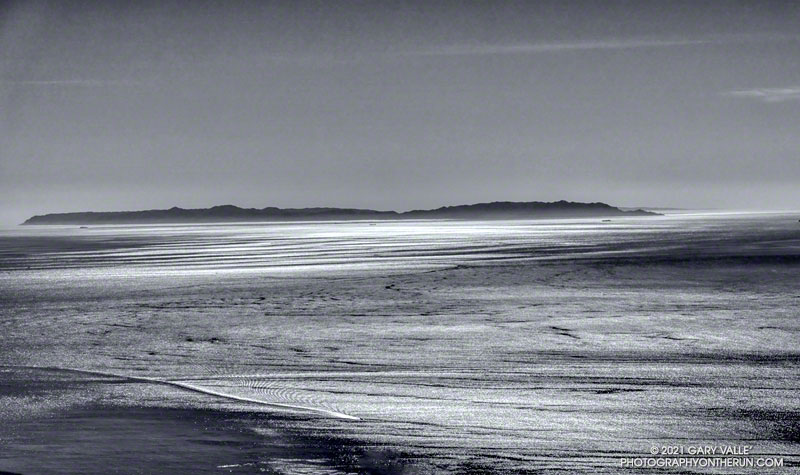
Another spectacular morning for a Southern California trail run.
The temperature on Saddle Peak was in the high-60s, with light winds out of the north.
The distance to Two Harbors from Saddle Peak is about 45 miles.

Another spectacular morning for a Southern California trail run.
The temperature on Saddle Peak was in the high-60s, with light winds out of the north.
The distance to Two Harbors from Saddle Peak is about 45 miles.
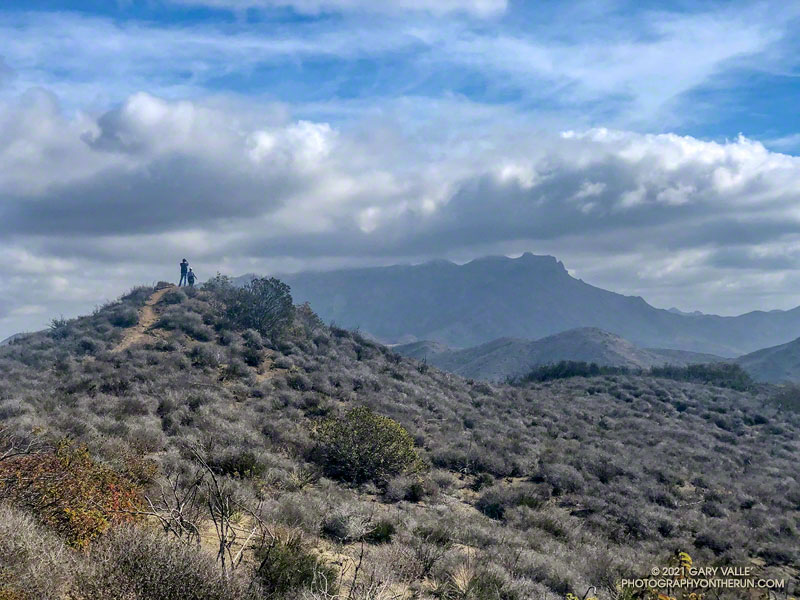
When I parked at the Wendy Drive trailhead, there was just enough light to see a wide band of high clouds overhead. That was good news. With a well-advertised storm expected to move through the area the next day, I hadn’t been sure what weather to expect for today’s run.
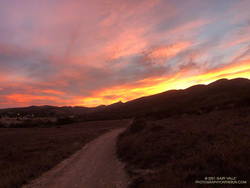
The general forecast was for low clouds and fog in the morning, giving way to partly cloudy skies in the afternoon. I was going to be running one of the more scenic trails in the Santa Monica Mountains — the Ray Miller Trail. High clouds and sunshine were a much better option than running in the fog or with gloomy, overcast skies.
Shortly after leaving the trailhead, the band of high clouds became underlit by the reds, oranges and yellows of the rising sun. It was going to be a good run.
The route-finding on this run is relatively straightforward. From the Wendy Drive trailhead on Potrero Road, run over to the Satwiwa Native American Indian Culture Center (see Satwiwa map). From the Culture Center run 4+ miles on Big Sycamore Canyon Road/Trail toward the beach. Some of this is paved.
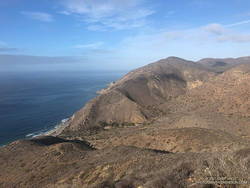
Once past the junction of Sycamore Canyon and Wood Canyon fire roads, take either the Wood Canyon Vista Trail (Backbone Trail) or Fireline Trail up to the Overlook fire road. From the top of the Wood Canyon Vista Trail turn left on Overlook fire road, or from the top of Fireline turn right, and follow the road to the top of the Ray Miller Trail. The Fireline option is about 0.4 miles longer. Here’s a map from the State Park website. Note that the La Jolla Canyon Trail is closed.
The Ray Miller Trail drops about 1000′ over 2.6 scenic miles. There is usually water available at the parking lot at the trailhead. Today the conditions were about as good as they get. The trail was in excellent condition. The temperature was in the mid-70s. The marine layer was holding offshore and a few puffy clouds had formed over the higher peaks.
One of the things about the Ray Miller Trail is that run/hike up it is almost as enjoyable as the run down. It is a very popular, and there are almost always runners and hikers on the trail. Running up a section of trail, I thought I recognized someone going down. It was nine-time Badwater finisher Chris Frost. We talked for a while about trails, running and races.
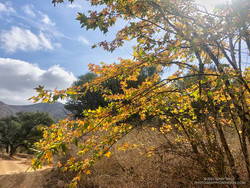
From Overlook Fire road the route back to Wendy was a familiar one — Hell Hill, Wood Canyon Fire Road, Two Foxes Trail, Big Sycamore Canyon Road, Upper Sycamore Canyon Trail, Danielson Road, and the Satwiwa Loop Trail. Including a short jog over to PCH the run was a little over 24 miles with about 3100′ of elevation gain.
Here’s an interactive, 3D terrain view of the Wendy Drive – Ray Miller Out & Back trail run. The map can be zoomed, tilted, rotated, and panned. To change the view, use the control on the upper right side of the screen. Track and placename locations are approximate and subject to errors. Poor weather, and other conditions may make this route unsuitable for this activity.
Some related posts: A Windy Run, Walk, Ride, for Wildlife Research; Running to Ray Miller; Ray Miller Training Run
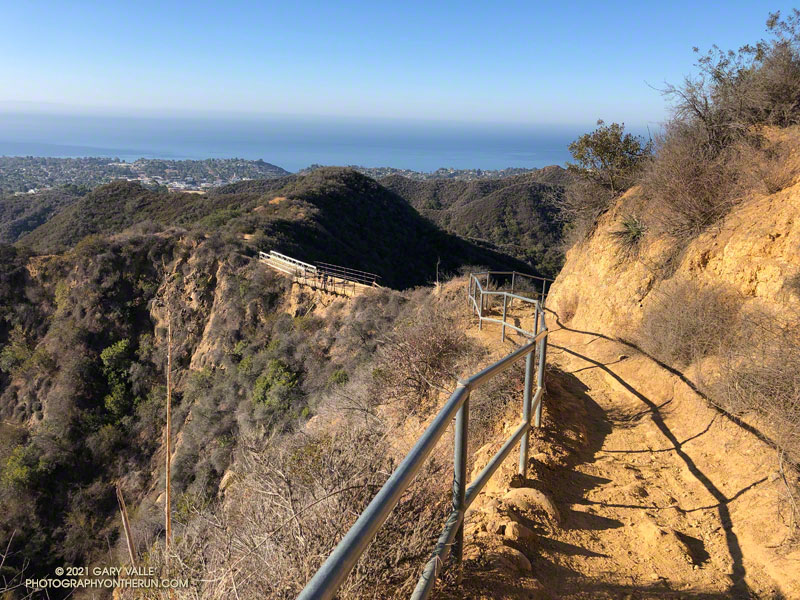
The previous weekend I’d done an out and back run from the “Top of Reseda” to the Oak Tree on the Rogers Road segment of the Backbone Trail. It’s an enjoyable run I could do on one bottle of water and get back by mid-morning. Including Temescal Peak, the run was about 14 miles roundtrip, with about 1800′ of elevation gain/loss.
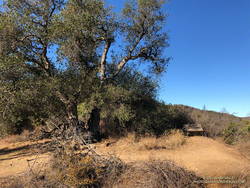
This weekend, I hadn’t expected to be back on the Backbone Trail and headed for the Oak Tree again, but last weekend’s run reminded me that I hadn’t done the Will Rogers – Rivas Canyon – Temescal Canyon/Ridge loop in a couple of years.
The 20+ mile loop is an outstanding trail run that is both challenging and scenic. Done clockwise from the Top of Reseda, the run down Rogers Road is as enjoyable as the climb out of Temescal Canyon is difficult. On paper, the elevation gain/loss is around 3400′, but for me the run is usually a bit more strenuous than that stat would suggest.
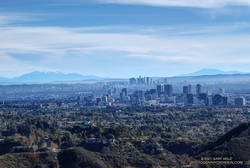
On the way out I usually do a short side trip to Temescal Peak, and on the way back a short detour to Temescal Lookout. With good visibility, both points have extensive, 360-degree views. Temescal Peak can be accessed from the Backbone Trail about 0.1 mile east of Temescal Ridge Fire Road via a use trail. Temescal Lookout is just off the Temescal Ridge Fire Road, about 0.5 mile north of the Trailer Canyon/Temescal Ridge Fire Road junction.
On a clear day, there is a long list of places and peaks visible along the route. Among them are Century City, Downtown, Santa Monica Bay, Palos Verdes, Catalina, Boney Mountain, Hines Peak, San Gabriel Mountains, Mt. Baldy, Santiago Peak, and sometimes San Gorgonio Mountain and San Jacinto Peak.
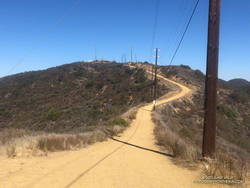
Water is usually available at Will Rogers State Historic Park at the restrooms adjacent to the main parking lot and polo field. I’ve also topped off my water at the Temescal Canyon trailhead. The Rivas Canyon Trail is used to connect Will Rogers SHP to Temescal Canyon.
Here’s an interactive, 3D terrain view of the Will Rogers – Temescal trail run. The map can be zoomed, tilted, rotated, and panned. To change the view, use the control on the upper right side of the screen. Track and placename locations are approximate and subject to errors. Poor weather, and other conditions may make this route unsuitable for this activity.
Some related posts: Will Rogers – Temescal Loop, Christmas Eve Trail Run, Chilly Los Angeles, Century City Clouds and Sun, Downtown Los Angeles and San Jacinto Peak
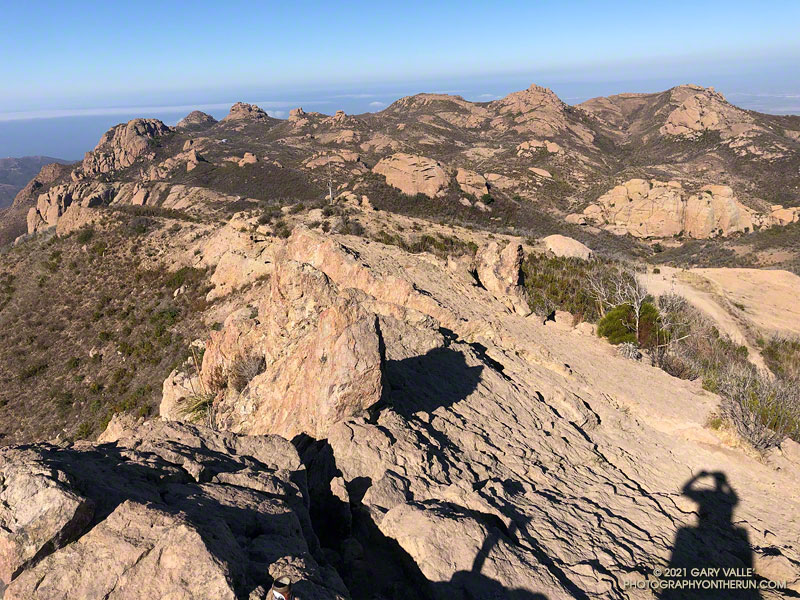
With the closure of Los Padres, Angeles, San Bernardino, and Cleveland National Forests until Thursday, I did not expect to find the summit of the highest peak in the Santa Monica Mountains empty. Even if it was by happenstance, I’ve rarely found the summit of Sandstone unoccupied on a Saturday or Sunday morning.
Like last weekend’s run, this morning’s trail run started at the Wendy Drive Trailhead on Potrero Road in Newbury Park. But today’s route had a lot more elevation gain, and some steep scrambling up the rocks of Boney Mountain’s Western Ridge. It’s an adventurous way to do Boney Mountain, Tri Peaks, and Sandstone Peak, and get in some excellent running on a very scenic stretch of the Backbone Trail.
Overall, the route was in the best shape I’ve seen since the 2018 Woolsey Fire. The path that works up the north side of Tri Peaks and around the east side of its summit blocks was relatively clear. Following trailwork by the Santa Monica Mountains Trails Council, the Chamberlain Trail segment of the Backbone Trail was once again an enjoyable downhill run.
Here’s an interactive, 3D terrain view of a GPS trace of my usual route (yellow) to Sandstone Peak from Wendy Drive via Boney Mountain’s Western Ridge, and return via Big Sycamore Canyon. A GPS track of the Cabin trail is also shown. Variations of the route include doing the Mishe Mokwa loop after climbing Sandstone Peak; and returning to Sycamore Canyon via Serrano Valley/Canyon instead of Blue Canyon.
Some related posts: Sandstone Peak from Wendy Drive, Over Boney Mountain to Sandstone Peak and Serrano Valley, An End of Year Boney Mountain Adventure, Too Many Flowers on the Chamberlain Trail
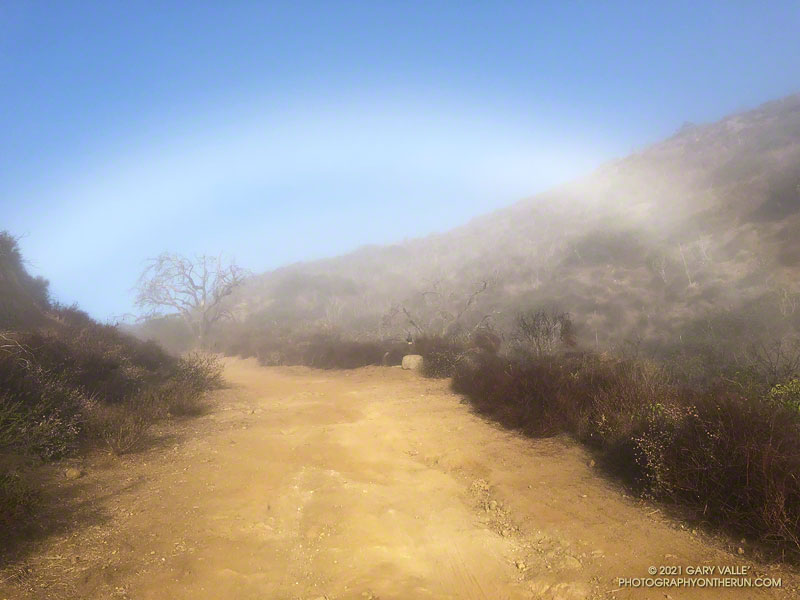
Fogbows form opposite the sun in a manner similar to rainbows, except the water droplets that create a fogbow are much smaller than raindrops. Because a fog droplet is so small, the physics of the interaction is different. The result is often a diffuse, primarily white bow.
The photograph of the fogbow was taken Sunday morning on an out and back run from Wendy Drive to Mugu Peak. The sun was about 14 degrees above the horizon. More about fogbows and other atmospheric phenomena can be found on Les Cowley’s Atmospheric Optics website.
Some related posts: Rainbow Colors in Cirrus Clouds Over Los Angeles, Out and Back Trail Run to Mugu Peak
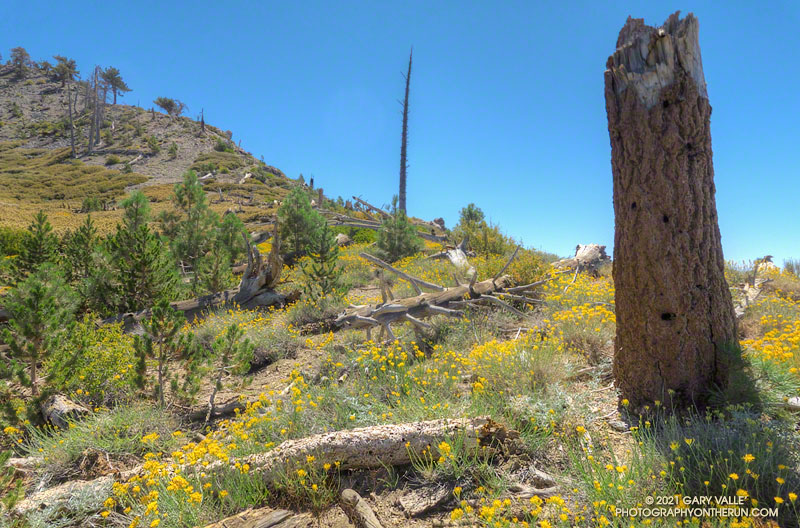
From mid Summer into Fall, the vibrant yellow flowers of rabbitbrush add a refreshing hit of color to the greens, grays, and browns of the San Gabriel Mountains.
The title photo was taken along the PCT, at an elevation of about 8600′, near Mt. Hawkins. The area was burned in the 2002 Curve Fire. Here, and elsewhere in the burn area, new trees — now in their teens — are slowly replacing some of the trees lost in the fire.
Related post: Bumblebee Feeding on Rabbitbrush